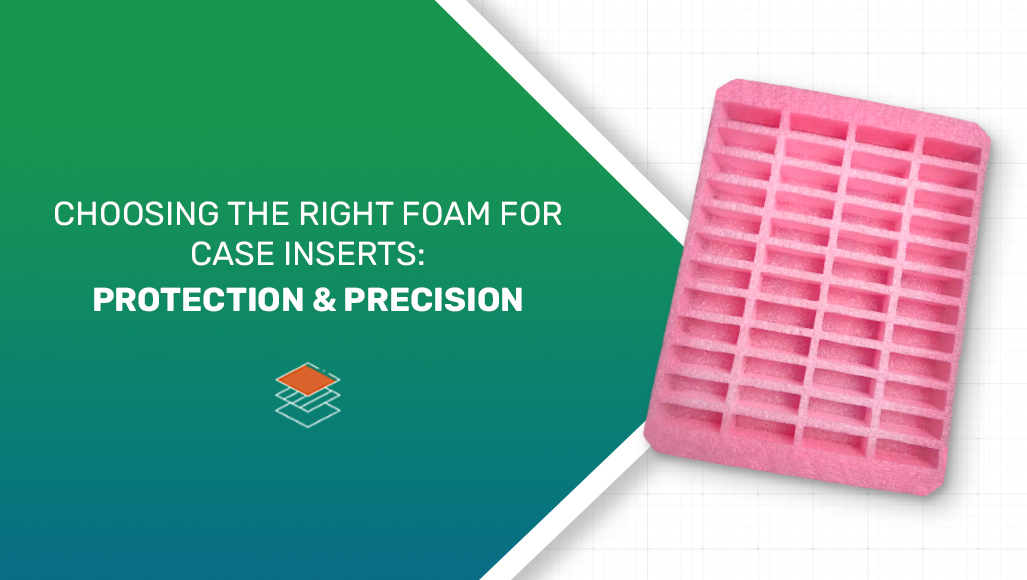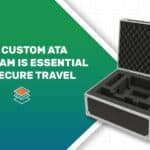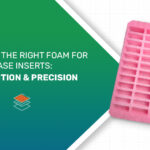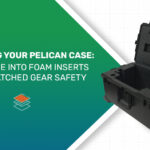Blog

Choosing the Right Foam for Case Inserts: Protection & Precision
Let’s face it, in the fast-paced world of business, the last thing anyone needs is for valuable equipment, delicate instruments, or essential tools to arrive damaged. It’s not just about the immediate financial hit from repairs or replacements; it’s about the lost time, the operational headaches, and the potential dent in your company’s hard-earned reputation. While a tough outer case is your first line of defense, the real unsung hero often lies tucked inside: the seemingly simple, yet surprisingly sophisticated, foam for case inserts. These inserts are a world away from basic padding. They are precision-engineered solutions, meticulously designed to cradle, secure, and shield your items from the bumps, drops, and vibrations they might face. This blog post is your guide to navigating the world of case inserts. We’ll explore the various types of foam on the market, walk you through how to pick the perfect match based on how fragile your items are, how much they weigh, and what you’ll be using them for. Ultimately, we want to help you lock in the best possible protection and precision for everything you value.
Thinking about high-quality foam for case inserts as just another expense misses the mark. It’s actually a smart, strategic move that pays off by protecting your gear, saving money down the line, and making your operations look sharper. The upsides are numerous and directly boost both your bottom line and how smoothly things run.
The number one job of foam in case inserts is to deliver top-notch protection. It does this by soaking up the shock from impacts and drops, stopping items from rattling around inside the case, and dramatically cutting down the risk of scuffs, collision damage, and outright breakage. When foam cavities are custom-designed, each item is held securely, which slashes the chances of damage that can happen when things shift or bang together during transit. The money saved by preventing this kind of damage can be pretty significant. Businesses avoid the cost of repairs, replacements, and the general headache of product loss. Take one aerospace and medical manufacturer, for example. They used to face about $150,000 in freight damage claims each year. After they switched their crating systems to include custom foam interiors, those claims vanished. And this was while their shipments went up by 40%, meaning their savings were projected to be even bigger. Plus, efficient packing, made easier by custom inserts, also shaves off labor time, adding to the cost savings.
But it’s not all about function; foam for case inserts also give your business’s assets a more professional and organized look. A custom-fitted foam insert doesn’t just protect; it looks sleek and seriously upgrades how your products or tools are presented. For things like tool cases, custom foam brings fantastic organization. You can quickly spot and grab the specific item you need. This “tool control” or “shadow boarding” – often done with contrasting foam layers – makes it instantly obvious if something’s missing. This helps prevent loss and ensures all the necessary bits and pieces are there before a job starts. This kind of organization makes work more efficient and sends a message of careful attention to detail and quality.
The shift from generic padding to highly specialized foam for case inserts shows a growing understanding that the cost of not protecting valuable assets is far higher than investing in the right protective solutions. More and more, businesses are seeing that the condition of their equipment, the happiness of their clients, and their ability to stay up and running are all directly tied to how well they pack and transport their goods. This change highlights a move towards protection that’s tailored to the item, where the foam solution gets as much careful thought as the item it’s built to protect.
Decoding Foam Types: A Comprehensive Guide to Materials
The real magic of foam for case inserts comes down to picking the right material for the specific task. Each type of foam has its own set of characteristics that make it a good fit for certain applications, item types, and even the environments it’ll face. Getting a handle on these differences is key to hitting that sweet spot of protection, durability, and value for money.
Polyethylene (PE) Foam: The Robust Protector
Polyethylene (PE) foam is a closed-cell material that’s a real heavyweight champion when it comes to rigidity, toughness, and absorbing shocks, especially for heavier items. Because it’s closed-cell, it doesn’t soak up water, which makes it super resistant to moisture, mildew, and a lot of chemicals. You can find PE foam in different densities. Standard PE usually clocks in around 2.2 lbs/ft³, but you can get higher-density versions, like 4 lbs/ft³ PE, which offer even more support for hefty loads and work well when you need thinner foam walls. It’s tough enough to take repeated hits and still keep cushioning. For standard PE foam, the temperature it can handle is generally between -30 to 150°F, while the 4# PE can go up to 180°F. Some sources even suggest a wider range of -60 to +90°C (-76 to 194°F) for certain PE foams. You’ll often see it used for packaging heavy industrial equipment, military gear, tools, and pretty much anything that needs serious support and impact resistance. For B2B uses where you need something tough that can handle challenging environments, PE foam is often the go-to material for case inserts.
Polyurethane (PU) Foam: The Gentle Cushion
Polyurethane (PU) foam is different; it has an open-cell structure. This makes it soft, flexible, and really good at molding around odd shapes and cushioning delicate, lightweight items. It gives good shock absorption for lighter things but, because of those open cells, it’s not naturally water-resistant. It can soak up moisture, which might cause it to break down over time in humid conditions. PU foam typically has a density around 1.6 lbs/ft³, but it can be made in various levels of firmness. Indentation Load Deflection (ILD) values, which tell you how firm it is, can vary a lot. Some soft PU packaging inserts might have an ILD of 75-85, while the kinds used in furniture can range from very soft (around 10-18 ILD) to extra firm (45-54 ILD). For packaging, it’s usually on the softer side. The typical temperature range PU foam can handle is -40 to 194°F (-40 to 90°C). It’s a common choice for protecting delicate electronics, camera gear, medical instruments, glassware, and things that scratch easily. It’s also used in presentation cases where you want a softer touch and feel. PU foam is your friend when you’re dealing with items that can’t take much G-force or have sensitive surfaces.
Cross-Linked Polyethylene (XLPE) Foam: Premium Performance & Durability
Cross-linked polyethylene (XLPE) foam is another closed-cell foam, but it stands out because of its very fine, even cell structure. This gives it superior durability, strength, chemical resistance, and a smooth, really nice-looking surface. It’s often called the “Cadillac” of foams because it also offers excellent thermal insulation and water resistance. Densities can vary quite a bit, for instance, from 2 lb/ft³ up to 15 lb/ft³. Because of the extra processing needed to cross-link the polymer chains, XLPE foam can be pricier than the non-cross-linked PE. Its top-tier qualities make it perfect for high-value items, medical devices, orthopedic supports, tool control inserts (those shadow boards we talked about), presentation cases, situations where you need a Class A surface finish, and any time longevity is a big deal. XLPE is a significant upgrade in both how it performs and how it looks for foam for case inserts.
Anti-Static Foams: Essential for Electronics Protection
If your business deals with electronics, anti-static foams aren’t just a nice-to-have; they’re absolutely essential to prevent costly damage from Electrostatic Discharge (ESD). ESD can be invisible but can wreak havoc on sensitive components. These foams work in a few different ways:
- Anti-Static (usually pink): These foams, often made from PE or PU, are treated to stop triboelectric charge generation – that’s the static buildup you get from friction. They typically have a surface resistance between 109 and 1012 ohms. It’s important to know that while they stop static from building up on themselves, they don’t shield components from external static fields and might let charges pass through. This often means you need a separate static shielding bag for complete protection.
- Static Dissipative: These foams let static charges flow to the ground more slowly and in a more controlled way than conductive foams do, which prevents sudden shocks. Their surface resistance is generally in the range of 105 to 109 ohms, and they can be pink or black.
- Conductive (typically black): Usually polyethylene-based and filled with carbon, these foams give static charges a quick path to ground and can create a Faraday cage effect, shielding what’s inside from external electrostatic fields. Their surface resistance is less than 106 ohms. One thing to keep in mind is that conductive foam can drain batteries if their conductive ends touch it directly.
Anti-static foams are vital for packaging and moving circuit boards, semiconductors, computer parts, and any other devices that are sensitive to static.
Other Considerations: Convoluted (Egg Crate) Foam
Convoluted foam, which you probably recognize by its “egg crate” texture, is usually made from polyurethane foam. That distinctive pattern of peaks and valleys gives it adaptive cushioning, making it good for irregularly shaped items and helping to spread weight evenly and absorb shock. When you use two pieces together, the convoluted surfaces can interlock, which improves stability and reduces how much the packaged items move around. It’s often used for lining case lids, for general-purpose cushioning when things aren’t super critical, or when you need a quick, adaptable solution within case inserts. While it might not be the first pick for really precise or heavy-duty jobs, it’s a cost-effective and versatile option.
Figuring out the “best” foam really depends on the situation. A premium material like XLPE isn’t automatically better if a simpler PU foam can do the job of protecting a lightweight, delicate item just as well, and at a lower cost. You should always do a bit of a cost-benefit analysis, thinking about the specific application and how valuable the item is. This will help you avoid over-engineering your solution or, worse, under-protecting your items. The wide range of specialized foams available today, like advanced anti-static types and super-durable XLPE, shows a bigger trend in the industry. Businesses now have access to, and are increasingly asking for, foam for case inserts that are precisely matched to complex needs. This means moving away from generic, one-size-fits-all approaches. It shows a growing awareness of the real cost of damage and the significant benefits that come from specialized protection. Another really important factor that sometimes gets missed is the temperature service range of the foam. If your items are going to be transported or stored in places that aren’t climate-controlled – think a hot truck, an unconditioned cargo hold, or a freezing warehouse – the foam could soften, get brittle, or just not protect as well if the temperatures go outside its specified service range. This could lead to unexpected failures in protection, which really highlights why you need to think about the temperature conditions across the entire supply chain when you’re picking your foam.
Making the Right Choice: Selecting the Ideal Foam For Your Case Inserts
Picking the right foam for case inserts is more than just choosing a material off a list; it’s about really thinking through what you’re protecting and how it’s going to be used. There are several key things to weigh up to make sure you get the best protection and precision.
Assessing Item Fragility: The G-Factor Explained
A really basic but crucial idea in protective packaging is the “G-factor.” This number tells you how fragile an item is. The G-factor is the maximum amount of shock or deceleration (measured in Gs, where 1 G is the force of gravity) that an item can take before it gets damaged. The lower an item’s G-factor, the more fragile it is, and the more cushioning it’s going to need. The main job of the foam in case inserts is to lessen any impact the outer case takes, making sure that the G-force that actually reaches the item stays below its specific G-factor. For instance, super fragile things like aircraft altimeters or gyroscopes might have a G-factor of 15-25 Gs. On the other hand, moderately tough items like major appliances can handle 85-115 Gs. Understanding this G-factor helps move foam selection from just guessing to a more data-driven, engineering-style approach. It’s also good to remember that an item’s G-factor isn’t always set in stone; it can change based on its internal design and even how it’s positioned in the foam insert. Supporting equipment at its strongest points can make it more resilient. An item might be more vulnerable to shock along one axis than another, so getting the orientation and support right within the foam can play to its natural strengths.
Factoring in Item Weight & Foam Density/Firmness
How much an item weighs is directly tied to the foam density and firmness you’ll need. Heavier items need denser, firmer foam to stop them from “bottoming out.” That’s when the foam compresses completely under the load and stops offering any more cushioning. On the flip side, lighter, more delicate items might need softer foam to give them enough cushioning without being too stiff, which could actually transmit shock instead of absorbing it. As pointed out by some experts, using light foam for heavy products can just lead to the foam flattening out, which totally defeats its purpose.
A key thing to calculate here is “static loading.” You get this by dividing the product’s weight by the area of its surface that’s touching the foam (measured in psi). This number helps figure out how much the foam will compress just from the item’s weight sitting on it, and it’s often used with foam cushioning curves. Another important measure is Indentation Load Deflection (ILD), which tells you how firm the foam is. ILD is the amount of force (in pounds) it takes to indent a foam sample by a certain percentage of its thickness (usually 25% for a 50 sq. inch area). A higher ILD value means firmer foam. For example, some packaging PU foams might have an ILD of 45 (which is firm), while other high-density PU foams used in furniture can range from about 19 to 86 ILD. Getting the foam firmness (ILD) wrong can be just as bad as not having enough foam thickness, especially for items that have a narrow G-factor tolerance. If the foam is too soft (low ILD) for a heavy item, it’ll compress too much, reducing the distance over which it can decelerate the item – much like if the foam wasn’t thick enough. If it’s too firm (high ILD) for a delicate item, it won’t compress enough to absorb the shock and will instead pass too much force through to the item.
Application-Specific Needs
What you’re actually going to do with the cased items makes a big difference in foam selection. Industrial tools might need tough, oil-resistant PE or XLPE foam. Delicate medical instruments, on the other hand, might need non-particulating PU or XLPE that cushions precisely, and maybe even has anti-static properties. Sales demo kits often need to look good, be easy to access, and use lightweight materials like PU.
The environment matters a lot too:
- Temperature Extremes: The foam’s service temperature range needs to be able to handle the conditions it’ll face during storage and transport.
- Moisture/Humidity: Closed-cell foams like PE and XLPE are much better for damp or humid places, as open-cell PU can soak up moisture.
- Chemical Exposure: PE and XLPE generally hold up well against many chemicals.
Also, “application-specific needs” can go beyond just the item itself and include things like regulatory or industry-specific rules. For example, packaging for medical devices might have really strict requirements for how clean the material is and whether it’s biocompatible. Military applications might need to meet specific MIL-STD for toughness or chemical resistance. Standardized testing also points to the formal evaluation processes prevalent in many sectors.
Durability and Longevity Requirements
How often you plan to use the case inserts and how long you need them to last are also important things to think about. Cases that are used every day for field equipment will need much more durable foam, like XLPE or higher-density PE, compared to inserts that are just for long-term storage or occasional shipping. Some foams, especially lower-density PU or the pre-scored cubes in pick-and-pluck foam, can break down, tear, or get permanently squashed over time with repeated use. Generally, closed-cell, higher-density foams last longer. Choosing a foam that can handle the expected wear and tear means you’ll get consistent protection for the whole time you intend to use the insert, avoiding early failures and potential damage to your products.
Beyond the Basics: Customization for Ultimate Protection & Precision
While picking the right foam material is the groundwork, getting to that top tier of “Protection & Precision” often means going custom. Tailoring the foam for case inserts to the exact shapes and support needs of your items takes the protective power way beyond what generic solutions can offer.
The Power of Custom-Cut Foam Inserts
Custom-cut foam inserts bring a host of benefits that directly tackle the main job of keeping valuable assets safe:
- Perfect Fit: When inserts are professionally designed, they’re cut to the exact dimensions of the items they’re holding. This pretty much stops internal movement – a major cause of damage during transit. Custom foam is engineered to be “always the perfect fit”.
- Maximized Protection: The foam is shaped to support items at their strongest points and give cushioning exactly where it’s needed most, not just to fill up empty space. This means you get the best shock absorption and force distribution.
- Organization and Efficiency: Having dedicated spots for each component, tool, or accessory makes packing and unpacking a breeze. This organization doesn’t just make things faster; it also makes it easy to see if anything’s missing, which is super important for tool control in field service kits or sets of critical equipment. “Shadow-boards,” made with layered, different-colored foams, are especially good for this.
- Professionalism and Presentation: Custom inserts make the contents look more valuable and give your brand a professional image. This can be a big deal for sales demonstration kits or when you’re delivering high-value products to clients.
Deciding to go for custom foam inserts often comes down to weighing the risks. DIY options might look cheaper at first, but the potential cost of damage to a high-value, critical, or sensitive item because of a poorly fitting insert can easily be much more than what you’d spend on a professional, custom solution. For many B2B situations, the better protection you get from custom foam is a smarter long-term investment.
DIY (Pick and Pluck) vs. Professional Customization
There are basically two ways to create cavities in case inserts: you can do it yourself with pick-and-pluck foam, or you can get it done professionally using advanced fabrication methods.
- Pick and Pluck Foam:
- Pros: This foam is usually cheap, easy to find, lets you customize it right away by hand, and you don’t need any special tools.
- Cons: The fit is often not very precise, leaving gaps that let items move around. The pre-scored cubes can tear beyond where you want them to, which leaves rough, messy edges and can waste foam space. It’s often not as durable, as the foam (usually a lower-density polyurethane) can break down or tear more with use. Overall, the protection is generally not as good as solid, custom-cut foam.
- Professional Customization (e.g., CNC, Die-Cut):
- Pros: This method gives you extremely precise cuts and can create really complex shapes and multi-depth cavities that perfectly match your equipment. It produces clean, professional-looking edges and lets you make the same design over and over again. Importantly, professional services can work with a wider variety of high-quality, durable foams, like XLPE, which offer much better protection.
- Cons: The initial cost is higher because it includes design services and often more premium materials. There’s also a lead time needed for the design and production process.
When is DIY Acceptable? For low-value items, situations where a perfect fit or a professional look isn’t a big deal, if you have plenty of time and patience, or if you’re on a really tight budget, pick-and-pluck foam might be okay.
When is Custom Essential? For valuable, sensitive, or mission-critical equipment (like cameras, electronics, medical devices, firearms, or specialized tools), for professional use cases, if items are transported frequently, or in any situation where you absolutely need the best protection and organization, professionally customized foam for case inserts are definitely the way to go. Advances in foam fabrication technology, like CNC machining, waterjet, and laser cutting, have made highly precise custom inserts more accessible and practical for a wider range of uses than they used to be. This means businesses that might have automatically gone for DIY solutions in the past because they thought custom was too expensive or complicated should take another look, as modern fabrication makes “precision” much more achievable.
Foam Fabrication Techniques Overview
Several clever techniques are used to create custom case inserts with high precision:
- CNC (Computer Numerical Control) Routing: Computer-guided cutting tools carefully sculpt the foam based on a digital design file. This method is great for creating complex shapes, multi-depth cavities, prototypes, and custom parts that need to be exact.
- Die Cutting: This process uses a custom-made steel rule die to stamp out precise foam shapes, kind of like a cookie cutter. It’s best for when you need to make a lot of identical inserts.
- Waterjet Cutting: A high-pressure stream of water is used to cut the foam. It produces intricate and exceptionally smooth cuts without generating heat that could mess with the material. This is ideal for really detailed and complex designs.
- Laser Cutting: A focused laser beam cuts through the foam with high precision and accuracy, resulting in fine, detailed cuts and smooth edges. This technique is often used for smaller, delicate inserts or ones that need intricate patterns.
Knowing about these fabrication methods gives you an idea of how the precision and complexity of custom foam inserts are achieved, which can also affect things like cost and how long it takes to get them made. Beyond just physical protection, the “tool control” or “shadow boarding” that custom foam inserts make possible offers some pretty big secondary benefits. These include making operations more efficient because tools are easier to find, simplifying inventory management, and preventing tool loss. All of this extends the return on your investment in custom foam for case inserts into operational cost savings and better productivity.
Conclusion: Investing in the Right Foam for Peace of Mind and Product Integrity
As we’ve journeyed through the details of foam for case inserts, one thing has become crystal clear: choosing carefully isn’t just a good idea, it’s absolutely vital for protecting your valuable assets. From getting to know the different characteristics of materials like polyethylene, polyurethane, and XLPE, to really thinking through how fragile your items are, how much they weigh, and what specific needs your application has, every step plays a crucial role in hitting those twin targets of protection and precision. The decision between a quick DIY option like pick-and-pluck foam and a professionally engineered custom insert really comes down to a solid assessment of risk, value, and how well it will perform over time.
At the end of the day, the right foam for case inserts should be seen as an investment, not just an expense. The cost of damaged equipment, delays in your operations, and a hit to your professional image can far outweigh what you spend upfront on a quality foam solution. Whether it’s tough PE foam for heavy industrial tools, gentle PU for delicate scientific instruments, or advanced anti-static foam for sensitive electronics, making the correct choice brings peace of mind and keeps your products intact. As products get more complex and sensitive, the need for even more sophisticated and precisely engineered case inserts is only going to increase. This will continue to drive innovation in both foam materials and how they’re made. Plus, the growing focus on sustainability might increasingly play a part in foam selection, with more businesses looking for recyclable options or designs that create less waste, adding another important layer to the decision-making process.
To make sure your assets get the best possible protection, it’s a good idea for businesses to really evaluate their specific needs. For items that are complex, high-value, or absolutely mission-critical, talking to packaging experts or specialist foam fabricators is highly recommended. These pros can offer invaluable advice, turning your requirements into tailored solutions that deliver uncompromising “Protection & Precision” for the things that matter most to your business.





